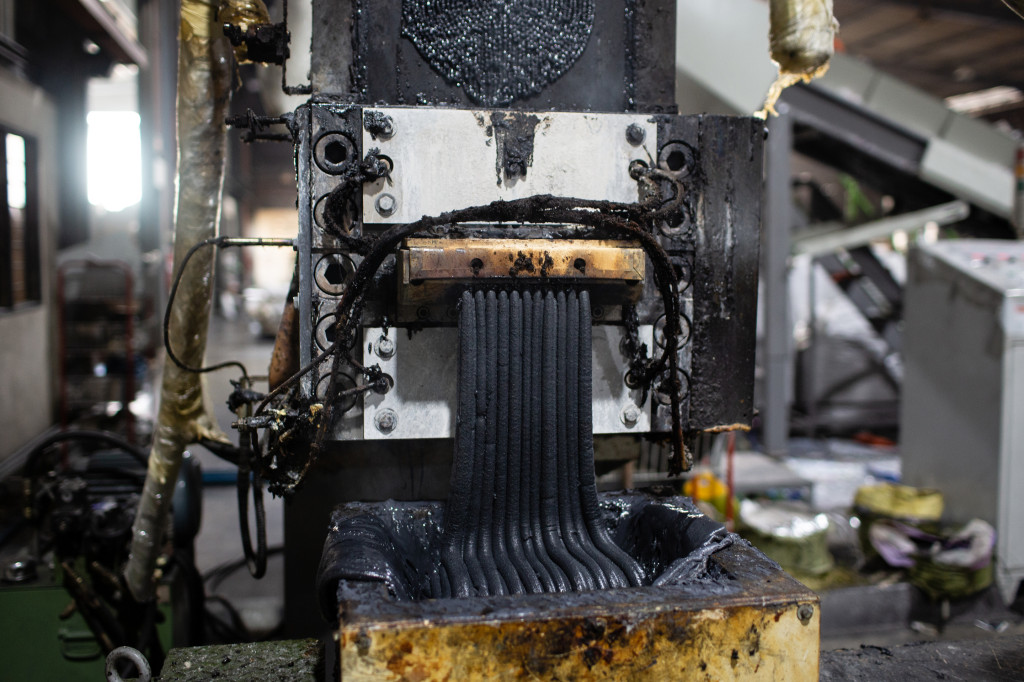
Cut into a hillside in northern Malaysia, amid oil palms and rubber trees, stands a large, open-air warehouse. This is the BioGreen Frontier recycling factory, which opened last November in the village of Bukit Selambau. On a searing-hot afternoon in January, Shahid Ali was working his very first week on the job. With his feet square in front of a chute on the production line, he stood knee-deep in soggy, white bits of plastic. Around him, more bits floated off the conveyor belt and fluttered to the ground like snowflakes.
Hour after hour, Ali sifts through the plastic jumble moving down the belt, picking out pieces that look off-color or soiled—rejects in the recycling process. Though it looks like backbreaking work, Ali says it is a great improvement over his previous job, folding bedsheets in a nearby textile factory, for much lower pay. Now, if he eats frugally, he can save money from his wages of just over $1 an hour and send $250 a month to his parents and six siblings in Peshawar, Pakistan, 2,700 miles away. “As soon as I heard about this work, I asked for a job,” says Ali, 24, a squat, bearded man with glasses and an easy smile. Still, he’s working 12 hours a day, seven days a week. “If I take a day off, I lose a day’s wages,” he says.
In the warehouse, hundreds of bales are stacked more than 60 feet high—each stuffed with plastic wrappers and bags tossed out weeks earlier by their original users. The address labels still stuck inside the bags offer clear clues to their origins. You can see toilet-tissue wrappers from a household in Half Moon Bay, Calif., packaging from El Paso, and polymeric film from energy-drink maker Red Bull’s U.S. headquarters in Santa Monica.
For this detritus, factories like Ali’s are the end of an odyssey of as much as 8,000 miles. The fact that the waste has traveled to this distant corner of the planet in the first place shows how badly the global recycling economy has failed to keep pace with humanity’s plastics addiction. This is an ecosystem that is deeply dysfunctional, if not on the point of collapse: About 90% of the millions of tons of plastic the world produces every year will eventually end up not recycled, but burned, buried, or dumped.
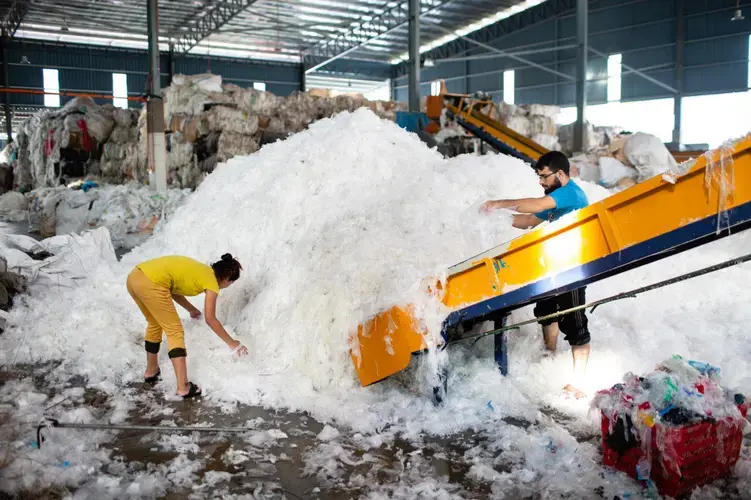
Plastic recycling enjoys ever-wider support among consumers: Putting yogurt containers and juice bottles in a blue bin is an eco-friendly act of faith in millions of households. But faith goes only so far. The tidal wave of plastic items that enters the recycling stream each year is increasingly likely to fall right back out again, casualties of a broken market. Many products that consumers believe (and industries claim) are “recyclable” are in reality not, because of stark economics. With oil and gas prices near 20-year lows—thanks in large part to the fracking revolution—so-called virgin plastic, a product of petroleum feedstocks, is now far cheaper and easier to obtain than recycled material. That unforeseen shift has yanked the financial rug out from under what was until recently a viable recycling industry. “The global waste trade is essentially broken,” says Graham Forbes, head of the global plastics campaign at Greenpeace. “We are sitting on vast amounts of plastic, with nowhere to send it and nothing to do with it.”
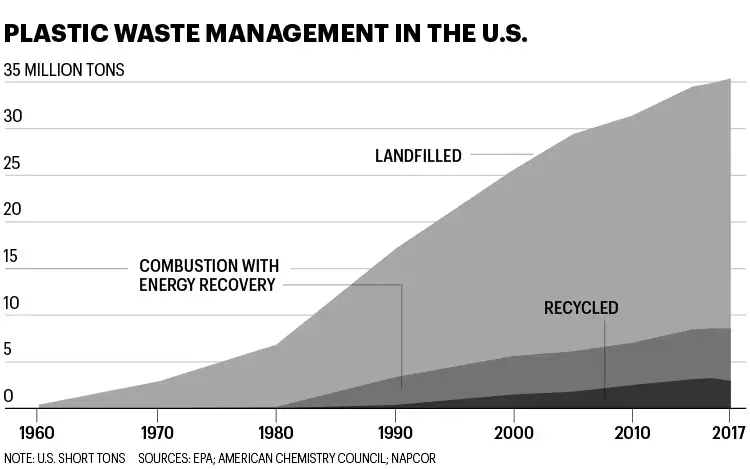
This gargantuan overload is creating a conflict that industry and government can no longer ignore—one that pits the profitability and usefulness of plastic against its threat to public health and the environment. There are few places where that conflict is more visible than in Malaysia. Here, rock-bottom wages, cheap land, and a still-evolving regulatory climate have enticed entrepreneurs to build hundreds of factories in a last-ditch bid to stay profitable. The real economic and environmental costs of plastic recycling are on vivid display, as I discovered traveling across the country with photographer Sebastian Meyer. Over the course of 10 days, we visited 10 recycling factories—some of them, including BioGreen Frontier, operating without official registration, under threat of a shutdown—as they grappled with waste shipped by the boatload from across the world. And we saw how the consequences of the broken plastics economy spill over into waste dumps, container dockyards, private homes, and out into the ocean.
For half a century, plastics have seen rocketing growth, for good reason: They are cheap, lightweight, and virtually indestructible. “There’s a great future in plastics,” a nervous young Benjamin Braddock (played by Dustin Hoffman) is told by a would-be mentor in the 1967 movie The Graduate. Acting on that tip would have yielded spectacular returns. Global production soared from 25 million tons a year in 1970 to more than 400 million tons in 2018.
Behind this polyethylene deluge is an economic colossus: a global plastics market worth about $1 trillion last year, according to U.K. data analysts the Business Research Co. Demand for plastics has doubled since 2000 and could double again by 2050. “We have a growing middle class around the world that needs to improve their quality of life,” says Keith Christman, managing director of plastic markets for the American Chemistry Council, an industry organization whose members include major producers like Dow, DuPont, Chevron, and Exxon Mobil. “Plastic is a part of that.” You can find plastic not just in your water bottles and sandwich bags, but in sweatshirts and wet wipes, home insulation and siding, chewing gum, tea bags, and countless other items.
Concerns about plastic have often been eclipsed by debates over carbon dioxide emissions. But the two are closely interlinked, with plastic production emitting considerable greenhouse gases itself. Now the world has fully awakened to the plastics crisis. Images of turtles choking on drinking straws or dead whales with stomachs engorged with plastic junk have gone viral—signifiers of the 8 million tons of plastic disgorged into oceans every year. (The UN Environment Program estimates that by 2050, the oceans will contain more plastic than fish.) The human toll is equally worrying. According to a study commissioned by the World Wildlife Fund, the average American consumes at least a teaspoon’s worth of plastic a week through food—roughly the amount in a credit card—with unforeseeable health consequences.
The durability that makes plastic so appealing, it turns out, also makes it an environmental time bomb. An estimated 90.5% of all the plastic produced since 1950 is still in existence, according to analysis by Roland Geyer, an industrial ecology professor at the University of California at Santa Barbara’s Bren School of Environmental Science & Management. Only 8.4% of plastic waste in the U.S. was recycled in 2017, according to the Environmental Protection Agency. An additional 15.8% was burned to generate energy; the rest wound up in landfills. Recycling rates are even lower in parts of Asia and Africa. Even Europe, with its stringent environmental laws, recycles only about 30% of plastics.
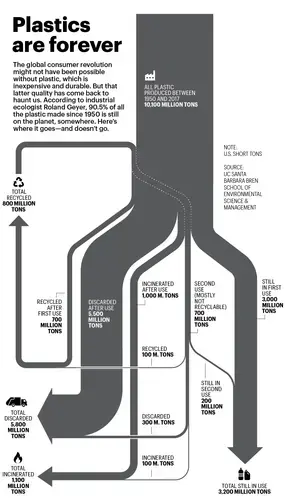
For decades, plastics producers and their biggest customers—consumer-goods giants like Coca-Cola, Nestlé, PepsiCo, and Procter & Gamble—have argued that improving these recycling numbers is the solution to the plastic-waste crisis. They frame the problem as one of behavior—ours. “It’s a knee-jerk reaction to say the problem is with plastic,” Tony Radoszewski, president and CEO of the Plastics Industry Association, tells me. “The culprit is the consumer who does not dispose of products properly.”
It’s true that recycling rates are low. But to blame that fact on consumers alone is disingenuous. The bigger problem is a huge shift in energy markets. Prices for oil and natural gas have plummeted over the past decade. That in turn has made it far cheaper for petrochemical companies to produce virgin plastics than for factories to create recycled plastic. And with big profits to be made, companies have sharply increased virgin production, further driving down prices. Recycling used plastic is labor-intensive and therefore expensive—and the shifting economics now work against recycling in much of the world.
In 2018, this ecosystem endured another major blow when China halted the importation of almost all plastic scrap, saying that its own recycling industry was becoming an environmental hazard. The decision has caused chaos in the world’s plastic-resuscitation economy. Up until then, for example, the U.S. had been sending about 70% of its plastic waste to China. Now, “recycling is on life support,” says Mike Engelmann, solid waste coordinator for Smithtown, N.Y., a town of 120,000 people on suburban Long Island. “Hopefully things will turn around. But I am not sure how.”
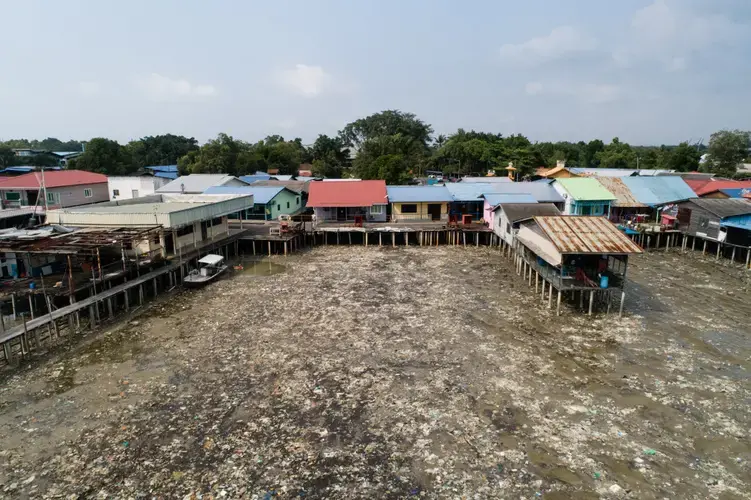
One turnaround option, curbing the production and use of virgin plastics, faces long odds, given the petrochemical and energy industries’ political clout. Indeed, a thriving plastics market has become pivotal to the energy sector’s long-term health. As automakers transition to electric vehicles, and renewable energy takes off, plastics will pick up the slack in oil-and-gas industry growth, according to the International Energy Agency. It estimates that petrochemical feedstocks, much of which go to make plastics, could rise from 12% of total global oil demand today to 22% in 2040—at which point the agency says feedstocks could be the only segment of the industry that’s growing at all.
It’s no surprise, then, that big companies’ responses to consumer concerns don’t emphasize the supply side. In January, big players like Dow, DuPont, Chevron, P&G, and other major players launched the Alliance to End Plastic Waste. The plastics crisis “demands swift action from all of us,” P&G CEO David Taylor told reporters.
But “swift action” did not include cutting production. Instead, companies committed to spending $1.5 billion over five years on projects to reclaim and recycle waste. Christman of the American Chemistry Council cites as one example the Renew Oceans project, which targets plastic pollution in India’s Ganges River. He says the alliance aims to make plastic packaging “100% recyclable” by 2030 and to make sure it all goes into the recycling stream by 2040. But when I ask who will bear the enormous cost of recycling such a mammoth amount, he hesitates, then says, “This will take funding. Part will come from industry, part from governments.”
Environmentalists say the sheer life span of plastics undermines that argument. What’s more, as Geyer’s research points out, most plastic that’s recycled after first use can’t be recycled again. Put another way: Almost every new piece of plastic we add to the planet may well stay here—along with almost all the old ones.
On a steamy afternoon, plastics trader Steve Wong sits at a small sidewalk eatery in the city of Ipoh, in central Malaysia. He’s meeting an old client, Saikey Yeong, CEO of local recycler AZ Plastikar. Under a roaring fan, the two men sit down to business over plates of spicy dumplings and pork rolls, washed down with jasmine tea. Their table is plastic, and so are their yellow chairs.
Wong takes out several bags and lays the contents in front of Yeong. In one are bits of clothing hangers he has collected from Paris fashion houses. In another is a tangle of plastic rope, the remnants of a polypropylene fishing net, which Wong acquired in the Netherlands. Hunched over the table, the men pull apart the net to check the polymers, at one point holding the flame of a plastic lighter up to the strands, to smell the smoke and determine its chemical makeup. “Look, this is good—we can recycle this, and there is a lot of it,” Wong tells Yeong. “The fishermen usually just dump this at the bottom of the sea.”
Wong is CEO of Fukutomi Recycling, a venerable name in the plastics industry, which he founded in 1984 in Hong Kong. He has the rough-and-ready mien of a door-to-door salesman, which, in a sense, he is. He spends much of his time traveling between the U.S., Europe, and Asia, attempting to match the hundreds of different polymers in plastic waste with whichever factories can process them. It is in settings like these—over $5 lunches and endless pots of tea, rather than in sleek corporate boardrooms—that crucial recycling deals are really decided. (On another afternoon, at another meeting, a Chinese factory owner plied Wong with homemade rice wine. As his wife cooked up a spread of Chinese dishes for us, he and Wong tested plastic samples in a rickety toaster oven.)
"The global waste trade is essentially broken."
- Graham Forbes, Head of the Global Plastics Campagin, Greenpeace
In Ipoh, Yeong agrees to buy about 600 tons of the polypropylene each month, for about $228,000 a month. But he fears being stuck with depreciating stock—a common experience these days. “Producing new plastic is so much cheaper than recycling,” Yeong says. “It is a very big problem for us.”
In factories across Malaysia, we hear similar tales. “If you came to me now and asked me to start this business, you had better just kill me,” says Yap Koon Fatt, 59, managing director of YB Enterprise, miming a gun to his head. Yap’s 10-acre recycling factory is set among oil palm trees in his hometown of Padang Serai, where he started recycling at 17. He currently recycles about 1,000 tons of plastic a month. But prices for his products have dropped 20% over the past six months, and Chinese orders have dropped by half.
In the Fizlestari factory, in Nilai, south of Kuala Lumpur, enormous bales of used water and juice bottles from Australia, the U.S., and Britain sit stacked to the ceiling. The factory brought in about $10 million in revenue last year, but its finished product sells for 25% less than in 2017, when the factory opened. “Prices have dropped a lot, a lot, a lot,” CEO Cecil Chan tells me. “And I don’t see them going back up anytime soon.”
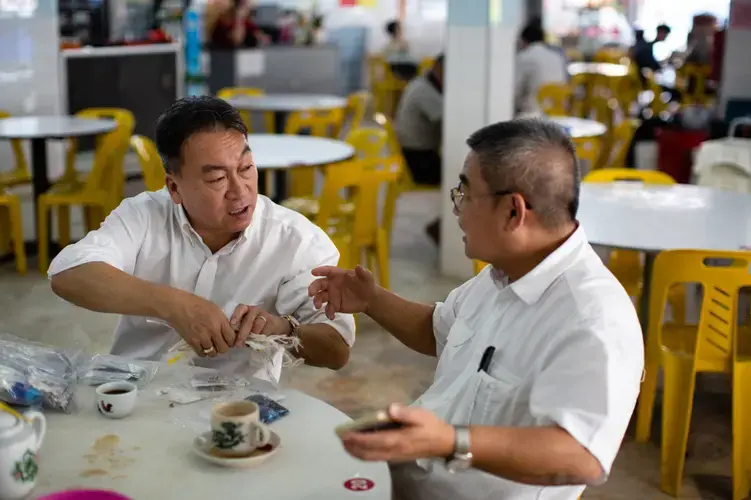
Wong, 62, has heard it all before, and he too is feeling the economic pain. He began as a boy in Hong Kong—“I was in primary school, not even teenage years,” he says—collecting trash for his father’s small recycling operation. He eventually grew the business into a profitable enterprise, and in 2000 he moved his wife and six children to Diamond Park, Calif. By then Wong operated more than 20 factories across the world, including in Germany, Britain, South Africa, and Australia. He says that most years he made $10 million in profit from his Hong Kong operation alone. Like most recyclers, his biggest market was China.
That all came crashing down in 2018, when China launched the ban it calls Operation National Sword. The country had long allowed enormous quantities of plastic-waste imports. But the vibrant industry that sprang up to process that waste eventually prompted complaints about the pollution it generated. Today, China will accept only waste that’s almost completely uncontaminated—a threshold barely 1% of items can clear. Globally, about 111 million tons of plastic waste will need to find other destinations within the next decade, according to the University of Georgia College of Engineering.
China’s actions shut the pipeline that had made Wong rich. He estimates his business has plummeted more than 90% since National Sword, and he has closed all but five of his factories. Now he makes most of his livelihood as a middleman, brokering waste to the thousands of recyclers that have opened in response to China’s drastic change. Many have relocated from China to Thailand, Vietnam, and Malaysia, drawn by cheap land—and even cheaper labor, in the form of migrants from Bangladesh, Pakistan, and Myanmar.
Venturing into the factories of Wong’s customers shows just how labor-intensive the work can be and why communities might not want the factories as neighbors.
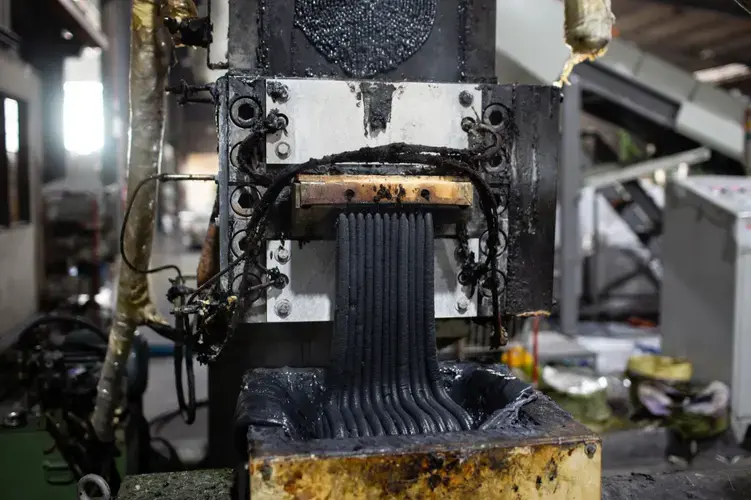
Inside, workers comb through containerloads of plastic waste. They sort through used plastic, separating materials such as PET (polyethylene terephthalate), which is widely used in drinking bottles and packaging, and LDPE (low-density polyethylene), the plastic in throwaway shopping bags. Each of the hundreds of polymers requires different processing. Once sorted, the waste is machine-washed and turned into yarn-like string. The string is then fed into a grinder, which turns it into pellets the size of grains of rice, known as nurdles. Recyclers pack the pellets into bales and sell them back to manufacturers as raw material. Much of the supply goes to factories in China, where it reenters the consumerism bloodstream as material for car parts, toys, water bottles, and thousands of other products.
The process is remarkable—but it has never been close to 100% efficient. Many polymers that users try to recycle are too low-grade for manufacturing. Soiled and damaged plastics often can’t be repurposed. And the price pressures created by the virgin plastic glut have only disrupted things further. “At the moment, there is no economic value to recycle this,” says Muralindran Kovindasamy, operations director in Ipoh for ResourceCo Asia, an Australian company. He buys some of the plastic Malaysian factories can’t use and sells it to cement companies as material for road paving. Most other recyclers simply burn or bury it. “Enforcement is poor,” he says, “and it’s cheap to dump it in the landfill.”
Yeo Bee Yin, then Malaysia’s environment minister, looked almost pained when I asked her how quickly Malaysia’s plastic-scrap trade has grown. Sitting in her top-floor office in the federal administrative center, Putrajaya, Yeo estimated that the trade contributes only $1 billion a year to the economy. Yet she saw herself as waging an all-out war against the operators. Malaysian recyclers require 19 different environmental permits to operate, and Yeo closed more than 200 factories last year alone, for lack of paperwork. If need be, she said, the government should “cut their electricity, cut their water, cut everything that is possible. They are gangsters.”
Yeo’s war awaits a new general: A few weeks after we spoke, she resigned with the rest of Malaysia’s cabinet amid a parliamentary crisis. But whoever succeeds her will have allies among health experts and ordinary citizens, for reasons evident even to the casual observer.
On our first morning in Malaysia, Sebastian Meyer and I climb a plastic mountain 50 feet high in the heart of Sungai Petani, a town of about 200,000 people near the island of Penang. This waste dump comprises plastics that nearby factories have deemed unrecyclable. It is the very end of the plastic supply chain. Burning it seems about the only next step, and someone is doing just that. Tneoh Shen Jen, a physician who directs the city’s Metro Hospital, says residents have experienced breathing problems as factories repeatedly and illegally burn the waste; they “smell burning plastic most nights,” he says.

In a neighborhood nearby, Tei Jean, 40, sits in her living room with her 6-year-old daughter. Their windows are sealed, and the house is stripped of toys, blankets, and curtains. It is a desperate effort by Tei to stop the girl’s respiratory infections, which she says began soon after recycling factories opened in their area last year. The girl has been hospitalized three times since then and last year stayed home from school for six months. “She kept getting worse,” Tei says. “Every time she left the house, her eyes would turn red.” Now the girl spends her days in the quiet, dark living room, drawing at a small pink table.
After protests from activists in Sungai Petani, factory owners stopped burning plastic last fall. But the two sides remain hostile. Last April, arsonists set ablaze two factories overnight. Their owners blame environmental groups. When we visited the town dump, a security guard snapped our photograph with his phone, then texted it to factories across Malaysia, to alert them to our presence. For days after, factory owners eyed us with suspicion, asking, “Are you with the environmentalists?”
On one occasion, we were. One day, near Sungai Petani, two activists guided us down a dirt road that ran alongside the Mudah River, a source of water for local farms. There, a short walk from a kindergarten, a large, unlicensed dump had sprung up. A chemical reek wafted up from pools of orange-colored water, filled with plastics instantly recognizable to Western consumers: Tide laundry soap bottles, Poland Spring water bottles, Green Giant frozen-pea packets. Locals explained that recyclers had discarded unwanted stocks here, in violation of Malaysian law. When a dump-truck driver spotted us, he hurriedly left the area. (Two days later, the site was set alight; local newspapers showed photos of thick black smoke rising over the trees.)
76 percent
Share of U.S. used plastic that ends up in landfills. Source: U.S. Environmental Protection Agency.
Malaysians hope to defend themselves from some of these depredations with the help of the Basel Convention on hazardous waste, which goes into effect next January. The convention bars the shipment of plastic contaminated with any kind of waste, and it has been signed by almost every country in the world—though not the U.S.
Malaysian officials have already begun blocking containers that they suspect violate the rules. On a blustery Sunday afternoon, customs officials escort us around Penang’s dockyard, showing us which containers are marked for return to the U.S., France, and Britain—at the shippers’ expense. Those returns can quickly get mired in a bureaucratic labyrinth, however. One container from Oakland, marked for repatriation, has sat on the dockside in Penang since June 2018.
Yeo, the former minister, believes plastic waste imports should be limited until the new Basel rules are strictly enforced, not only in Malaysia but also in nearby recycling hubs like the Philippines and Indonesia. People are increasingly rankled by the trade, she says. “Why are we a dumping ground for you? Because it is more convenient for you?” she asks me. “The feeling is there is perhaps injustice in it.”
In truth, few people give even a passing thought to where their trash goes. Most assume that after they wheel their garbage bins to the sidewalk, a well-oiled recycling system takes over.
Early one January morning, we tracked Smithtown’s garbage trucks as they proved how far off the mark that assumption is. On the first recycling day of 2020, the trucks tipped out 103 tons of plastic at a collection center that was once a full-service recycling facility. In 2014, Smithtown earned about $878,000 selling its waste to eager recyclers. Now, they pay nearly $80,000 a year to get disposal companies to take it off their hands.
Smithtown’s difficulties typify what has happened across the U.S.—and they predate China’s ban. As oil and gas prices crashed, the market for the town’s used plastic dried up; virgin plastic was simply cheaper. So it drastically cut its recycling and now accepts only higher-quality polymers, called “ones” and “twos”—the numbers inside the triangle recycling icon. Lower-grade plastics, numbered three to seven, are no longer marketable. Hundreds of towns across the U.S. have made similar decisions, and dozens have simply stopped curbside recycling altogether.
$1 trillion
Estimated annual revenue of the global plastics industry. Source: The Business Research Company.
These days, a trucking company collects Smithtown’s plastic waste and delivers it to the Sims Municipal Recycling Center in Brooklyn. Since Long Island, where Smithtown is located, bans solid-waste landfilling, many low-grade plastics wind up being burned for electricity at a plant in nearby Huntington. Actual recycling of the waste is almost out of the question, says Smithtown sanitation supervisor Neal Sheehan. “It is still cheaper to ship it across the world to someplace, to come back as something,” he says.
If current trends continue, that’s unlikely to change. Oil and gas companies are making major investments in a future virgin-plastic boom. Multinational goliath Royal Dutch Shell is building a mammoth complex near Pittsburgh—one of America’s fracking epicenters—that will produce about 3.5 billion pounds a year of polyethylene plastic. (The plant won a 25-year tax break from the Pennsylvania state legislature that’s worth an estimated $1.6 billion.) In January, Taiwan’s Formosa Plastics Group won approval from state lawmakers to build a $9.4 billion plastic-production complex in Louisiana, which it says will create 1,200 jobs.
These plants are an environmental problem in their own right. The Center for International Environmental Law, an advocacy group, argues that the industry’s expansion could pose “a significant and growing threat to the earth’s climate.” It calculates that the greenhouse gases emitted in the production of plastics will equal the output of about 615 new coal plants by 2050. And Geyer, the UC–Santa Barbara professor, estimates that by then, the world will be creating more than 1.1 billion tons of virgin plastic a year.
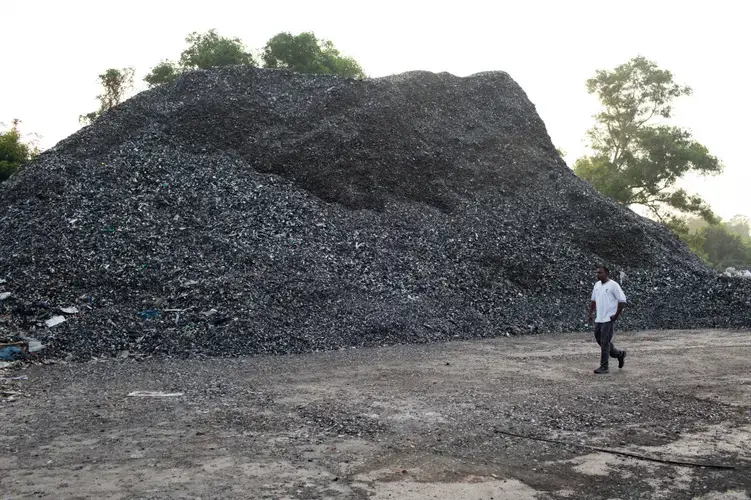
Geyer says that after years of studying industry data, he has reached one conclusion. “There is one thing we absolutely must do, and it is also the hardest,” he says. “We have to commit ourselves to stop growing the production of virgin plastic.”
Yet plastic producers’ capacity to resist that outcome seems as sturdy as a laundry-soap bottle, especially in the U.S. Bans on bags and other “single use” plastics are a case in point. Beginning in 2021, single-use plastics will be strictly controlled in the European Union’s 27 countries, and plastic bags will be banned in major cities in China. In the U.S., petrochemical companies have largely stymied such proposals. Only eight U.S. states ban single-use plastics. At the national level, a measure introduced in February by two Democratic U.S. senators would make companies share the burden of recycling and impose a moratorium on virgin-plastic growth. But Radoszewski, CEO of the Plastics Industry Association, calls the second measure “a nonstarter.”
Radoszewski says plastic-ban proposals are simply “virtue signaling” by politicians, and argues that alternatives like glass, metal, and paper are more polluting over their life span. The association lobbies relentlessly to send similar messages to lawmakers. “Don’t let naysayers dictate the story of plastics,” the group told its members in announcing its national conference on March 25. “Educate those on Capitol Hill about what we already know: Plastics help change people’s lives for the better.”
For all the fighting words, there are signs that some businesses are rethinking plastics—in part because of pressure from concerned customers.
Some clothing companies have proved that recycled plastics can command a luxury premium. In 2017, Adidas began selling high-end sneakers made of plastic waste hauled from the ocean off the coast of the Maldives. The $200 shoes have been a sold-out hit, and Adidas made 11 million pairs last year. The company says it now aims to eliminate virgin plastic from its production completely. Nike has also designed sportswear from recycled polyester and plans to expand that effort.
Behavioral changes in the packaged-goods world could have an even bigger impact. Unilever CEO Alan Jope said last October that the company would “fundamentally rethink” its packaging—its plastic footprint exceeds 700,000 tons a year—and halve virgin-plastic use by 2025.
Advances in recycling also show promise. Unilever has partnered with SABIC, a company owned by Saudi Aramco, to create packaging using chemical recycling, a process that breaks down used plastics and converts them into material it says is as good as virgin. And IBM last year said it had created a chemical process to eat through PET and turn it into nurdles—in a process it says is far more efficient and scalable than the painstaking washing and sorting in factories like the ones we visited in Malaysia.
"Cut their water, cut everything. They are gangsters."
- Yeo Bee Yin, former Malaysian Environment Minister, speaking about local plastic recyclers who violate pollution laws.
Several owners of those factories see promise in these moves—a glimmer of hope that their nurdles might finally become desirable commodities again. “Nike and Adidas want to tell customers they care about the earth and will use 100% recycled plastics,” says Adu Wu, chief operating officer for Grey Matter Industries, a Taiwanese recycler. The recent announcements might signal a turning point, he says. “We want to be part of that.”
Back at BioGreen Frontier, company director Engboon Ooi, 56, says he too hopes changing behavior among multinationals could help him land big deals. In the meantime, he’s preoccupied with short-term woes. Ooi is still waiting for official permits for his factory and risks being shut down. And in late January, BioGreen and other recyclers, like much of the global economy, were hit with a body blow from the coronavirus. Within weeks, China shut down factories and ports and canceled orders for recycled-plastic pellets, causing havoc for recyclers. By phone in mid-February, Ooi told me he has begun stockpiling nurdles in the warehouse, while hunting for other clients. “I don’t want to send the workers home,” he says.
Those workers continue to flood into Malaysia from some of the world’s poorest countries, eager to recycle the waste from some of its richest. For them, the plastic-waste industry, even in its depressed state, remains a large step up the economic ladder. “I have worked here for two months,” says Aung Aung, 25, from Yangon, Myanmar, as he stands on the BioGreen production line. He says recycling plastic pays far more than his previous restaurant jobs in Penang. “I need to think about my family,” he says.
Shahid Ali, meanwhile, has big plans. He says he will work at BioGreen for two more years before returning to Peshawar. “I will get married then,” he says, standing amid the sodden washed plastic. “I have already chosen a girl.” Until then, he’s willing to spend 84 hours a week on the recycling line—building a home, figuratively speaking, out of plastic scraps.
Pushing Back on Plastic
Our appetite for plastic is almost limitless; the planet’s ability to absorb it is not. Barely 9% of used plastics are recycled worldwide, and about 8 million tons are dumped into the oceans every year. A growing wave of popular anger over plastic waste is pushing companies to take bolder steps to tackle the problem. These three approaches are gaining momentum.

1. Chemical recycling
The plastics industry is bullish on this strategy to address the global glut. The method involves breaking down plastics that are typically landfilled or burned, like plastic wrappers, film, and coffee pods, into their raw chemical ingredients. Those are then mingled with virgin resins to make materials that are just as strong as new plastic. There are downsides, however. The process generates a substantial carbon footprint, for example, limiting its overall benefit to the climate.
2. Bioplastics
Unlike traditional plastic, which is made from petroleum feedstocks, bioplastics are produced by extracting sugar from corn or sugarcane and turning it into polylactic acids or polyhydroxyalkanoates. Those materials look and feel much like carbon-based plastics, without the fossil fuel consumption. Critics note that crops for bioplastics require pesticides and hog land on which food could be grown. And recycling bioplastics requires high heat in composting plants, increasing the risk that used items will be landfilled.
3. Pay-per-package
One way to counteract a broken recycling market: require companies to pay city governments to recycle their plastic packaging. In most of the European Union and some Asian countries, such laws already exist. In the U.S., Maine’s legislature is considering a similar bill. Plastic makers say they would prefer to boost recycling rates rather than shoulder the costs. But in Europe, the laws have helped spur companies to cut packaging and rethink their use of plastic.



